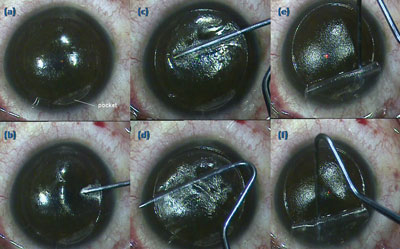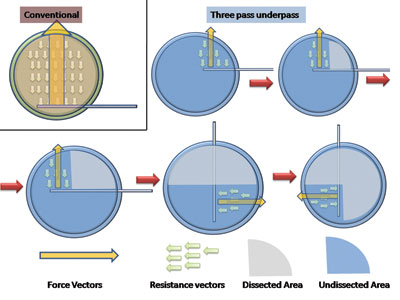Technique avoids stress on flap during femtosecond laser-assisted sub-Bowman’s keratomileusis
The three-pass-underpass technique allows careful handling of the flap during dissection and lifting.
 Amar Agarwal |
Femtosecond laser-assisted sub-Bowman’s keratomileusis has emerged in recent years with good visual and refractive outcomes and a good biomechanical profile. The current technology available to create a sub-Bowman’s flap with a 60-kHz femtosecond laser has been shown to be satisfactory in terms of visual outcomes and architectural profile regarding planarity and predictability.
As these flaps are thin, they require more careful manipulation and correct direction of the dissector tip. Sporadic reports of intraoperative complications such as vertical gas breakthrough and flap tear with flaps less than 100 µm have been published. The surgical technique most surgeons follow to separate and lift a sub-Bowman’s flap is no different that for a thicker flap. The conventional method consists of opening the side cut with a Seibel IntraLase Flap Lifter and Re-treatment Spatula (Rhein Medical) or a similar device; inserting the longer, blunt end from an area near the hinge via the side cut opening; and guiding the spatula from the superior to the inferior area (in case of a superior hinge) with single or multiple strokes to separate the flap all along the lasered area.
Three-pass-underpass technique
We noticed that the resistance force generated at the start of the stroke to lift the flap depends on the undissected area ahead of it. If a surgeon is starting flap separation close to the hinge, the undissected area is about the same size as the flap diameter (more than 8.5 mm), which could lead to undue stress on the flap, resulting in flap tears. Therefore, we conceptualized a new technique to avoid undue mechanical stress on the flap while dissecting and lifting the flap. We call this the three-pass-underpass technique.
 Figure 1. The three-pass-underpass technique, a graded flap dissection technique for thin femtosecond sub-Bowman keratomileusis flaps. Images: Agarwal A |
 Figure 2. Force vector diagrams with the conventional technique compared with the three-pass-underpass technique. |
With this technique, docking, centration and initiation of the femtosecond laser pass and opening the side cut is done as in the conventional technique (Figure 1a). The three-pass-underpass variation starts with a temporal pass, in which the Seibel spatula is inserted from 2 o’clock (surgeon’s view) for the right eye or 10 o’clock (surgeon’s view) for the left eye, and the first pass is made with the direction of the force being toward the stromal side rather than the flap side (Figure 1b). This constitutes a little less than one-third of the area to be separated and steered away clear of the pupil. The second pass is done adjacent to the first pass, and it covers the entire pupillary area (Figure 1c). The remaining third of the undissected flap is now cleared in a third pass (Figure 1d). The end result after the three passes is a flap that has been separated from the stromal bed in three-fourths of the area, with only the superior one-fourth near the hinge left to separate. The Seibel spatula is now inserted under the flap in the center, and the flap is then freed up to the hinge by a sweeping movement toward the temporal and nasal periphery in a sequence depending on the surgeon’s preference (Figures 1e and 1f). Thus, the entire flap is dissected and reflected back without creating excessive pressure on the hinge.
Results
In a recently concluded study, 150 consecutive cases scheduled for a tissue-saving LASIK treatment with 90-µm flaps (n = 68) or 100-µm flaps (n = 82) underwent flap lift and subsequent laser with this technique. This was compared with retrospective data of 150 cases with 90-µm flaps (n = 63) or 100-µm flaps (n = 87) that underwent the conventional technique before introduction of the three-pass-underpass technique. The achieved flap thickness and visual outcomes were comparable for the two groups. No cases of flap tear were seen in the three-pass-underpass group compared with two in the conventional control group.
Discussion
A femtosecond flap requires mechanical separation of small uncut areas interspersed within the cut area by blunt dissection, and thus, there have been few instances of flap tear while attempting to lift thin flaps. With other factors being the same — bed energy, spot separation, surgeon — the graded technique of flap lift resulted in the reduction in pressure at the hinge and thus reduced the risk of flap tear.
Figure 2 explains the rationale why this new technique appears to be safer. The inset box shows force vector diagrams with the conventional technique when starting the dissection from near the hinge. Multiple areas of uncut tissue create small vectors of resistance force that summate against the separating force created by the spatula. The larger undissected area ahead of the spatula, with higher resistance noted, results in an equally higher force vector, which if misdirected by a sudden wrong stroke of the spatula, may result in a flap tear. In the case of a three-pass-underpass technique as shown in Figure 2, the undissected area ahead of the spatula is lesser, creating a lesser resistance force that needs to be overcome by the force vector, which is safer in case of an inadvertent misdirection of the spatula stroke. Therefore, in terms of a biophysical simulation, the three-pass-underpass technique seems to be a safe alternative to conventional thin-flap lift technique femtosecond LASIK. The results of the recent study have also demonstrated the benefit of this technique for dissection of sub-Bowman’s flaps. As the learning curve is very small for this method, surgeons can incorporate the same process in dissecting thin flaps.
References:
- Azar DT, Ghanem RC, de la Cruz J, et al. Thin-flap (sub-Bowman keratomileusis) versus thick-flap laser in situ keratomileusis for moderate to high myopia: case-control analysis. J Cataract Refract Surg. 2008;34(12):2073-2078.
- Chang JS. Complications of sub-Bowman’s keratomileusis with a femtosecond laser in 3009 eyes. J Refract Surg. 2008;24(1):S97-101.
- Dawson DG, Grossniklaus HE, McCarey BE, Edelhauser HF. Biomechanical and wound healing characteristics of corneas after excimer laser keratorefractive surgery: is there a difference between advanced surface ablation and sub-Bowman’s keratomileusis? J Refract Surg. 2008;24(1):S90-96.
- de Benito-Llopis L, Teus MA, Gil-Cazorla R, Drake P. Comparison between femtosecond laser-assisted sub-Bowman keratomileusis vs laser subepithelial keratectomy to correct myopia. Am J Ophthalmol. 2009;148(6):830-836.
- Prakash G, Agarwal A, Jacob S, Kumar DA, Agarwal A. The three pass-underpass technique: a graded flap dissection technique for thin femtosecond sub-Bowman keratomileusis flaps. Eye Contact Lens. In press.
- Prakash G, Agarwal A, Yadav A, et al. A prospective randomized comparison of four femtosecond LASIK flap thicknesses. J Refract Surg. 2010;26(6):392-402.
- Slade SG, Durrie DS, Binder PS. A prospective, contralateral eye study comparing thin-flap LASIK (sub-Bowman keratomileusis) with photorefractive keratectomy. Ophthalmol. 2009;116(6):1075-1082.
- Srinivasan S, Herzig S. Sub-epithelial gas breakthrough during femtosecond laser flap creation for LASIK. Br J Ophthalmol. 2007;91(10):1373.
- Amar Agarwal, MS, FRCS, FRCOphth, is director of Dr. Agarwal’s Eye Hospital and Eye Research Centre. Prof. Agarwal is the author of several books published by SLACK Incorporated, publisher of Ocular Surgery News, including Phaco Nightmares: Conquering Cataract Catastrophes, Bimanual Phaco: Mastering the Phakonit/MICS Technique, Dry Eye: A Practical Guide to Ocular Surface Disorders and Stem Cell Surgery and Presbyopia: A Surgical Textbook. He can be reached at 19 Cathedral Road, Chennai 600 086, India; fax: 91-44-28115871; e-mail: dragarwal@vsnl.com; website: www.dragarwal.com.
- Disclosure: Dr. Agarwal has no direct financial interest in the products discussed in this article, nor is he a paid consultant for any companies mentioned.

